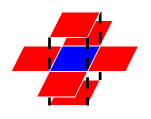8.1 深度优先搜索(DFS)
The K−P factorization of a positive integer N is to write N as the sum of the P-th power of K positive integers. You are supposed to write a program to find the K−P factorization of N for any positive integers N, K and P.
Input Specification:
Each input file contains one test case which gives in a line the three positive integers N (≤), K (≤) and P (1). The numbers in a line are separated by a space.
Output Specification:
For each case, if the solution exists, output in the format:
N = n[1]^P + ... n[K]^Pwhere n[i] (i = 1, ..., K) is the i-th factor. All the factors must be printed in non-increasing order.
Note: the solution may not be unique. For example, the 5-2 factorization of 169 has 9 solutions, such as 1, or 1, or more. You must output the one with the maximum sum of the factors. If there is a tie, the largest factor sequence must be chosen -- sequence { , } is said to be larger than { , } if there exists 1 such that ai=bi for i<L and aL>bL.
If there is no solution, simple output Impossible.
Sample Input 1:
169 5 2Sample Output 1:
169 = 6^2 + 6^2 + 6^2 + 6^2 + 5^2Sample Input 2:
169 167 3Sample Output 2:
Impossible
#include<cstdio> #include<vector> using namespace std; int n,k,p,maxfacSum = - 1; vector<int> temp,ans,fac; int power(int x){ int ans = 1; for(int i = 0; i < p;i++){ ans *= x; } return ans; } void init(){ int temp = 0,i = 0; while(temp <= n){ fac.push_back(temp); temp = power(++i); } } void DFS(int index,int nowK,int sum,int facSum){ if(nowK == k && sum == n){ if(facSum > maxfacSum){ ans = temp; maxfacSum = facSum; } return; } if(nowK > k || sum > n) return; if(index-1 >= 0){ temp.push_back(index); DFS(index,nowK+1,sum+fac[index],facSum+index); temp.pop_back(); DFS(index-1,nowK,sum,facSum); } } int main(){ scanf("%d%d%d",&n,&k,&p); init(); DFS(fac.size()-1,0,0,0); if(maxfacSum == -1){ printf("Impossible "); }else{ printf("%d = %d^%d",n,ans[0],p); for(int i =1;i<ans.size();i++){ printf(" + %d^%d",ans[i],p); } } return 0; }
8.2 广度优先搜索(BFS)
One important factor to identify acute stroke (急性脑卒中) is the volume of the stroke core. Given the results of image analysis in which the core regions are identified in each MRI slice, your job is to calculate the volume of the stroke core.
Input Specification:
Each input file contains one test case. For each case, the first line contains 4 positive integers: M, N, L and T, where M and N are the sizes of each slice (i.e. pixels of a slice are in an M×N matrix, and the maximum resolution is 1286 by 128); L (≤) is the number of slices of a brain; and T is the integer threshold (i.e. if the volume of a connected core is less than T, then that core must not be counted).
Then L slices are given. Each slice is represented by an M×N matrix of 0's and 1's, where 1 represents a pixel of stroke, and 0 means normal. Since the thickness of a slice is a constant, we only have to count the number of 1's to obtain the volume. However, there might be several separated core regions in a brain, and only those with their volumes no less than T are counted. Two pixels are connected and hence belong to the same region if they share a common side, as shown by Figure 1 where all the 6 red pixels are connected to the blue one.

Figure 1
Output Specification:
For each case, output in a line the total volume of the stroke core.
Sample Input:
3 4 5 2
1 1 1 1
1 1 1 1
1 1 1 1
0 0 1 1
0 0 1 1
0 0 1 1
1 0 1 1
0 1 0 0
0 0 0 0
1 0 1 1
0 0 0 0
0 0 0 0
0 0 0 1
0 0 0 1
1 0 0 0Sample Output:
26#include<cstdio> #include<queue> using namespace std; struct node{ int x,y,z; }Node; int m,n,l,T; int pixel[1290][130][61]; bool inq[1290][130][61] = {false}; int X[6]={0,0,0,0,1,-1}; int Y[6]={0,0,1,-1,0,0}; int Z[6]={1,-1,0,0,0,0}; bool judge(int x,int y,int z){ if(x<0 || x>=m || y<0 || y>=n||z<0 || z>=l){ return false; } if(inq[x][y][z] == true || pixel[x][y][z] == 0) return false; return true; } int BFS(int x,int y,int z){ int tot = 0; queue<node> Q; Node.x = x,Node.y = y,Node.z = z; Q.push(Node); inq[x][y][z] = true; while(!Q.empty()){ node top = Q.front(); Q.pop(); tot++; for(int i=0;i<6;i++){ int newX = top.x + X[i]; int newY = top.y + Y[i]; int newZ = top.z + Z[i]; if(judge(newX,newY,newZ)){ Node.x = newX,Node.y = newY,Node.z = newZ; Q.push(Node); inq[newX][newY][newZ] = true; } } } if(tot >= T) return tot; else return 0; } int main(){ scanf("%d%d%d%d",&m,&n,&l,&T); for(int z=0;z<l;z++){ for(int x=0;x<m;x++){ for(int y = 0;y <n;y++){ scanf("%d",&pixel[x][y][z]); } } } int ans = 0; for(int z=0;z<l;z++){ for(int x=0;x<m;x++){ for(int y = 0;y <n;y++){ if(pixel[x][y][z] == 1 && inq[x][y][z] == false){ ans += BFS(x,y,z); } } } } printf("%d ",ans); return 0; }